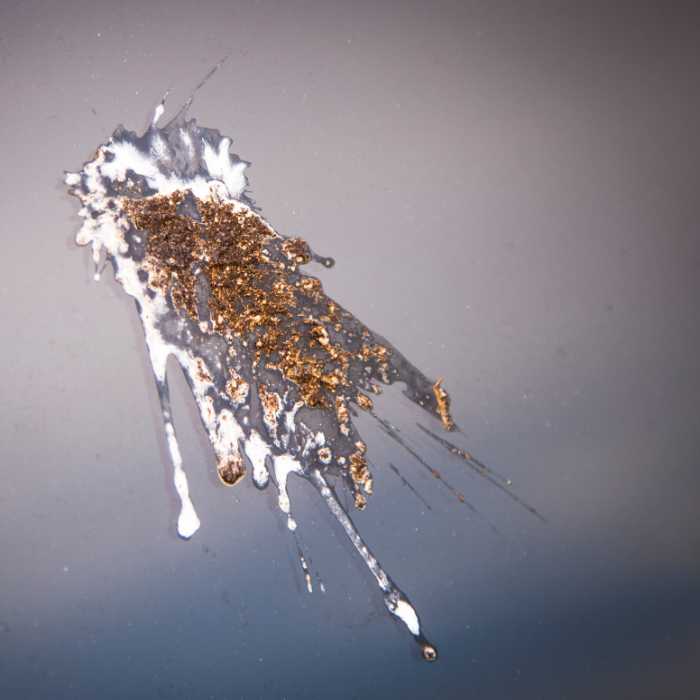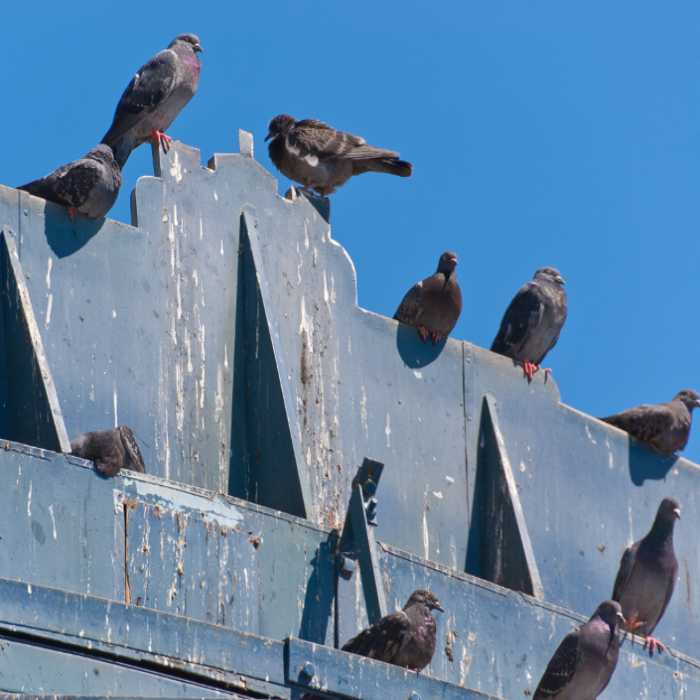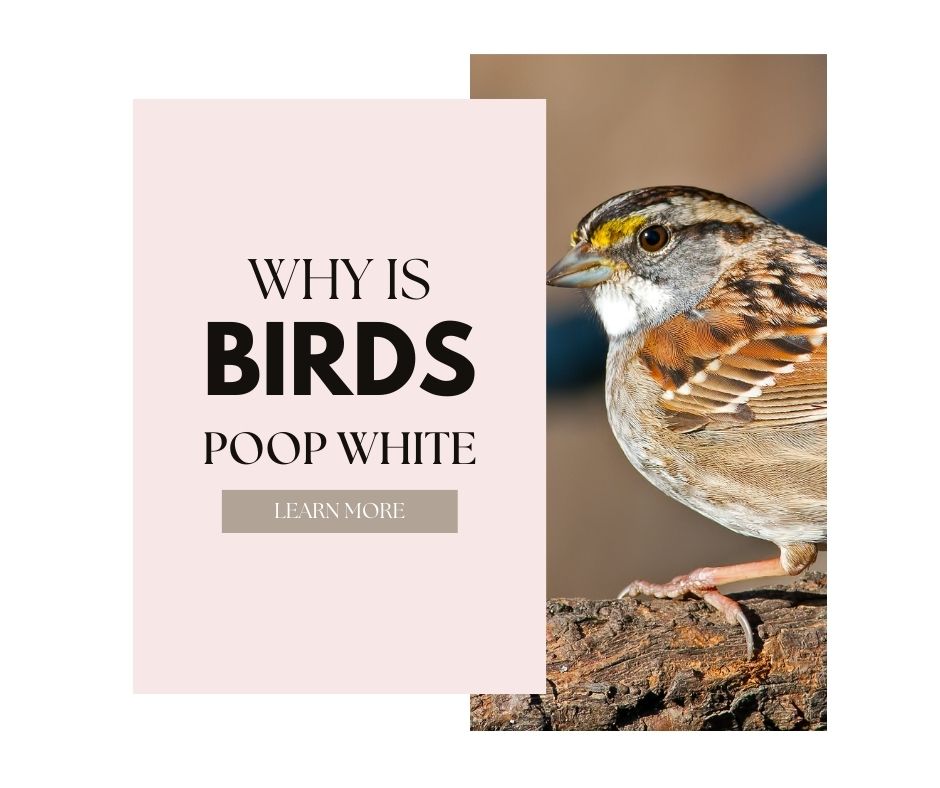Why Is Birds Poop White
Table of Contents
Have you ever wondered, why is bird poop white? It’s a question that’s probably crossed your mind at least once in your life, especially after finding that unwelcome “gift” on your car or outdoor furniture. You’ll be surprised to learn that understanding bird poop can reveal more about these creatures than you might think.
First off, it’s essential to know that bird poop isn’t entirely white! In fact, it contains both white and black components. The white part is made of uric acid, which is a waste product from the bird’s kidneys. Birds don’t produce liquid urine like humans and most mammals; instead, they excrete uric acid as a paste. This adaptation helps birds reduce their body weight for more efficient flying, and conserves water, especially for species that inhabit dry environments.
As for the black part of bird poop, it’s actually their fecal matter. This consists of digested food and comes from the bird’s digestive tract. If you notice, the black and white elements of bird poop are often found together in a single dropping, which is because both waste products exit the bird’s body through the same opening, called the cloaca. So the next time you see a white and black splatter, just remember it’s a mix of uric acid and digested food that has everything to do with how birds efficiently remove waste from their bodies!

The Science Behind Bird Poop Color
Ever wondered why bird poop is white? It’s all about the unique qualities of their digestive system! Think back to your biology class, and you might recall something about birds having a combined excretory system.
This means that birds don’t urinate and defecate separately like mammals do. Instead, their waste output comes from a single organ called the cloaca. As a result, bird poop is a combination of both urine and feces, which blends together to produce that familiar white color.
Nitrogenous Waste
It’s important to understand the role of nitrogenous waste in bird poop color. In mammals like humans, nitrogenous waste is excreted in the form of urea, a water-soluble compound that gives urine its distinctive yellow color. Birds, on the other hand, produce a different substance called uric acid.
Here are some key differences in nitrogenous waste compounds between mammals and birds:
| Mammals | Birds | |
|---|---|---|
| Compund | Urea | Uric Acid |
| Solubility | Water-soluble | Insoluble in water |
| Color | Yellow | White |
Uric acid has a few unique properties:
- It’s insoluble in water, which means it forms a white paste-like substance rather than a liquid.
- Uric acid doesn’t require as much water to excrete, making it more concentrated and resulting in a striking white color.
Diet and Dehydration
The whiteness of a bird’s poop can also be affected by factors like diet and dehydration. For example, fruit-eating birds might produce droppings that have a hint of color from the fruits they consume. In contrast, birds like pigeons, which are primarily grain-based eaters, will tend to produce whiter feces.
Here are some examples of how diet can affect bird poop color:
- Fruit eaters: Brighter colored feces due to fruit pigments
- Grain eaters: Whiter feces because of a lack of pigmentation in grains
Occasionally, you might notice bird poop appearing darker. This could be a sign of dehydration as the uric acid becomes even more concentrated or an indication that the feces portion is predominant.
So, there you have it! The science behind bird poop color boils down to their unique digestive and excretory systems, their uric acid-based waste, and external factors like diet and hydration levels. Now, the next time you spot white bird poop, you’ll know exactly why it looks the way it does!
Bird Digestive Systems Explained
Why is bird poop white? It’s actually due to their unique digestive system. Unlike mammals, birds have a different way of processing food, and this directly impacts the color of their droppings. Let’s take a closer look at how it all works.
First, it’s important to understand that birds have a special organ called the crop. This is where food is stored before it moves to the stomach. What is unique about the crop is that it can store food for long periods of time, allowing birds to eat larger amounts in one go, which is particularly useful during migration or in harsh conditions.
The stomach is divided into two parts: the proventriculus and the gizzard. In the proventriculus, digestive enzymes are added to the food, breaking it down. Next, the gizzard, which is a strong muscular organ, does the “chewing” as it grinds the food into smaller particles.
Once the food has been broken down, it moves on to the small intestine, where nutrients are absorbed. Birds don’t have a bladder to store liquid waste like we do. Instead, they have two kidneys that extract excess water and waste, turning it into uric acid. Uric acid is the white, pasty substance found in bird poop.
And finally, there’s the cloaca – a multipurpose opening at the end of the digestive tract. It’s where the bird’s waste, both solid and liquid, gets expelled from the body.
Now that we’ve established how the bird digestive system works, let’s explore why their feces appears white. Here are a few key points:
- Uric acid: This is the white substance that makes up a large portion of bird droppings. It’s a waste product that forms crystals and has a low solubility in water, which essentially means it doesn’t dissolve well.
- No bladder: Birds do not have a separate exit for liquid waste, so both solid and liquid waste gets mixed together, creating the typical bird poop consistency.
- Efficiency: Birds have a very efficient digestion and waste elimination process, which is essential for their ability to fly long distances. Producing lightweight waste, like uric acid, helps them stay as light as possible.
Understanding these points about the bird digestive system can help you appreciate the unique aspects of their biology. So the next time you see white bird poop, you’ll know it’s all part of nature’s efficient design for these amazing creatures.

Bird Diets: Why It Matters
Have you ever wondered what birds eat? Their diet plays a key role in the color and consistency of their poop. Since bird diets vary greatly, let’s dive into a few common diets and explain how it affects their waste.
Seed-eaters, like sparrows and finches, consume a diet rich in seeds. Seeds have a tough outer shell composed of lignin and cellulose. These indigestible materials result in more solid waste, which can cause the greenish-brown part of the bird poop.
Predatory birds, such as hawks and eagles, have a diet primarily composed of meat. In contrast to seed-eaters, these carnivorous birds produce less solid waste due to the higher digestibility of their meals. By eating meat, they also consume more white uric acid, which is responsible for the white coloring in their poop.
Fruit-loving birds, like parrots and pigeons, feast on a variety of fruits and berries. This type of diet can produce poop with a more liquid consistency. It’s also worth noting that the color of the fruits they consume can sometimes affect the look of their waste. Naturally, the more uric acid a bird consumes due to their diet, the whiter their droppings will be.
Here are some quick facts about bird diets and how they can influence their poop:
- Seed-eaters: Solid waste, greenish-brown poop
- Predatory birds: Less solid waste, white poop due to uric acid
- Fruit-loving birds: Liquid waste, color influenced by fruit
When it comes to a bird’s diet, remember that quality matters. High-quality birdseed contains nutrients and enzymes required for a bird’s digestive system to function properly. A balanced diet also affects the bird’s overall health, which in turn can make their waste less smelly and more manageable.
- Keep your birdseed fresh and free from mold
- Provide a variety of nutrient-rich foods for your pet bird
- Ensure that your bird has an adequate amount of calcium in their diet
By understanding the connection between bird diets and their poop, you’ll be able to provide a healthier environment for your pet. Happy and healthy birds make for happier bird owners! So, give extra attention to their diet and enjoy the benefits of better waste management in return.
The Role of Uric Acid
Have you ever wondered about the science behind those little white droppings from our feathered friends? It’s quite fascinating, really! In this section, we’ll dive into the role of uric acid and why bird poop is white.
For starters, let’s think about how your body processes waste. When you eat, your body produces waste that eventually leaves your body as, well, you know the drill. In humans and other mammals, the process involves breaking down waste into urea, which is then excreted as urine. Birds, however, handle waste disposal differently. They primarily produce uric acid, which gives their waste its characteristic white color.
So, why do birds produce uric acid? It all comes down to water conservation. Unlike mammals, birds don’t produce urine and don’t have a separate system for excreting liquid waste. Instead, they combine both solid and liquid waste into one expulsion. Producing uric acid rather than traditional urine helps them:
- Save water: Uric acid is less soluble in water, which means birds retain more water in their bodies. This is especially helpful for birds living in arid environments where water is scarce.
- Reduce weight: Because uric acid is solid, it weighs less than liquid waste. This can be a crucial factor for birds, especially for those who fly long distances.
Since uric acid is responsible for the unique texture and color of bird droppings, let’s look at its properties:
- It is a nitrogen-containing compound, derived from the breakdown of amino acids.
- It forms a white, chalky paste when mixed with solid waste.
- It’s less toxic than urea.
Another interesting aspect is related to how birds eliminate uric acid. As mentioned earlier, birds don’t have separate systems for solid and liquid waste. Both are excreted through the cloaca, a multipurpose opening at the base of a bird’s tail.
In summary, uric acid is responsible for the white color of bird poop. It’s an essential part of their waste disposal system, offering benefits like water conservation and reduced weight. Plus, it’s a fascinating example of how nature adapts to different environments and challenges in unique ways! So, the next time you spot some white droppings on your car, take a moment to appreciate the science behind it.

White Poop: Pros and Cons for Birds
You might be wondering, why is bird poop white? It’s a little weird, right? But it turns out, there’s a reason for it – and some pros and cons for our feathered friends. Let’s dive in and explore this phenomenon.
Birds have one hole for waste – the cloaca. Both poop (solid waste) and urine (liquid waste) come out of this singular hole. Unlike mammals, birds don’t have separate exits for waste. Bird poop is white because it’s a mix of solid waste and uric acid, the bird’s version of urine. Here are some pros and cons of this unique bird feature:
Pros:
- Efficiency: Combining solid and liquid waste into a single exit saves space and weight in the bird’s body. When it comes to flying, every bit of weight reduction and compactness helps!
- Hydration: By producing uric acid crystals instead of liquid urine, birds conserve water. This is especially useful for birds living in dry environments or during long flights without water access.
- Fertilizer: Bird poop can be a great natural fertilizer. The uric acid in the white part contains nitrogen, which is essential for plant growth.
Cons:
- Mess: Bird poop can be a bit of an eyesore, especially when it ends up on your car, outdoor furniture, or walkways. When it dries and hardens, it can be tough to clean.
- Health hazards: Bird droppings can sometimes carry diseases that can be harmful to humans, such as histoplasmosis, cryptococcosis, and psittacosis. However, the risk of getting sick from casual contact is low.
- Corrosive effects: Uric acid in bird poop can be corrosive over time, especially if it accumulates on metal surfaces. This can lead to damage to cars, outdoor structures, and monuments.
Curious about the actual color of bird poop? Well, the uric acid is the white part, but you may also notice darker portions. These darker bits are the actual solid waste – digested food that has traveled through the bird’s digestive system. So, the next time you see bird poop, you’ll know there’s more to it than meets the eye!
Final Thoughts
So, now you know the answer to the question of why bird poop is white. Let’s take a quick look back at the key info:
- Birds’ digestive systems combine both solid and liquid waste
- White part of their droppings is uric acid, a byproduct of breaking down protein
- Uric acid helps in conserving water in their bodies, crucial for their survival
As a bird lover, understanding their digestive process may give you a new perspective on these fascinating creatures. No doubt their poop can be a nuisance, but it’s an essential part of their biology that keeps them healthy and flying high.
It’s always fun to learn new aspects about the birds you come across every day, and sharing this knowledge with your friends and family will make for some interesting and lighthearted conversations.
Remember, an understanding of nature and its creatures, even when it comes to something as simple as bird poop, can foster greater empathy for our feathered friends. So the next time you spot some bird droppings on a sidewalk or your car, smile, and appreciate the amazing internal workings that keep these wonderful creatures soaring.






